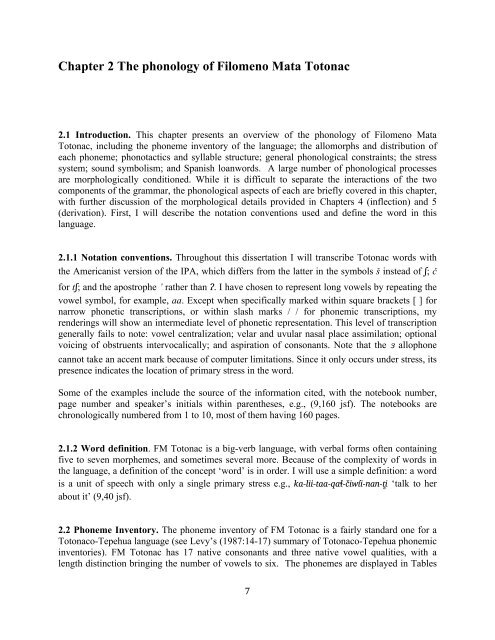The phonology and morphology of Filomeno Mata Totonac
The phonology and morphology of Filomeno Mata Totonac
The phonology and morphology of Filomeno Mata Totonac
You also want an ePaper? Increase the reach of your titles
YUMPU automatically turns print PDFs into web optimized ePapers that Google loves.
Chapter 2 <strong>The</strong> <strong>phonology</strong> <strong>of</strong> <strong>Filomeno</strong> <strong>Mata</strong> <strong>Totonac</strong><br />
2.1 Introduction. This chapter presents an overview <strong>of</strong> the <strong>phonology</strong> <strong>of</strong> <strong>Filomeno</strong> <strong>Mata</strong><br />
<strong>Totonac</strong>, including the phoneme inventory <strong>of</strong> the language; the allomorphs <strong>and</strong> distribution <strong>of</strong><br />
each phoneme; phonotactics <strong>and</strong> syllable structure; general phonological constraints; the stress<br />
system; sound symbolism; <strong>and</strong> Spanish loanwords. A large number <strong>of</strong> phonological processes<br />
are morphologically conditioned. While it is difficult to separate the interactions <strong>of</strong> the two<br />
components <strong>of</strong> the grammar, the phonological aspects <strong>of</strong> each are briefly covered in this chapter,<br />
with further discussion <strong>of</strong> the morphological details provided in Chapters 4 (inflection) <strong>and</strong> 5<br />
(derivation). First, I will describe the notation conventions used <strong>and</strong> define the word in this<br />
language.<br />
2.1.1 Notation conventions. Throughout this dissertation I will transcribe <strong>Totonac</strong> words with<br />
the Americanist version <strong>of</strong> the IPA, which differs from the latter in the symbols # instead <strong>of</strong> #; $<br />
for t#; <strong>and</strong> the apostrophe ’ rather than $. I have chosen to represent long vowels by repeating the<br />
vowel symbol, for example, aa. Except when specifically marked within square brackets [ ] for<br />
narrow phonetic transcriptions, or within slash marks / / for phonemic transcriptions, my<br />
renderings will show an intermediate level <strong>of</strong> phonetic representation. This level <strong>of</strong> transcription<br />
generally fails to note: vowel centralization; velar <strong>and</strong> uvular nasal place assimilation; optional<br />
voicing <strong>of</strong> obstruents intervocalically; <strong>and</strong> aspiration <strong>of</strong> consonants. Note that the Πallophone<br />
cannot take an accent mark because <strong>of</strong> computer limitations. Since it only occurs under stress, its<br />
presence indicates the location <strong>of</strong> primary stress in the word.<br />
Some <strong>of</strong> the examples include the source <strong>of</strong> the information cited, with the notebook number,<br />
page number <strong>and</strong> speaker’s initials within parentheses, e.g., (9,160 jsf). <strong>The</strong> notebooks are<br />
chronologically numbered from 1 to 10, most <strong>of</strong> them having 160 pages.<br />
2.1.2 Word definition. FM <strong>Totonac</strong> is a big-verb language, with verbal forms <strong>of</strong>ten containing<br />
five to seven morphemes, <strong>and</strong> sometimes several more. Because <strong>of</strong> the complexity <strong>of</strong> words in<br />
the language, a definition <strong>of</strong> the concept ‘word’ is in order. I will use a simple definition: a word<br />
is a unit <strong>of</strong> speech with only a single primary stress e.g., ka-lii-taa-qa"-c%iwíi-nan-ti& ‘talk to her<br />
about it’ (9,40 jsf).<br />
2.2 Phoneme Inventory. <strong>The</strong> phoneme inventory <strong>of</strong> FM <strong>Totonac</strong> is a fairly st<strong>and</strong>ard one for a<br />
<strong>Totonac</strong>o-Tepehua language (see Levy’s (1987:14-17) summary <strong>of</strong> <strong>Totonac</strong>o-Tepehua phonemic<br />
inventories). FM <strong>Totonac</strong> has 17 native consonants <strong>and</strong> three native vowel qualities, with a<br />
length distinction bringing the number <strong>of</strong> vowels to six. <strong>The</strong> phonemes are displayed in Tables<br />
! +!

















